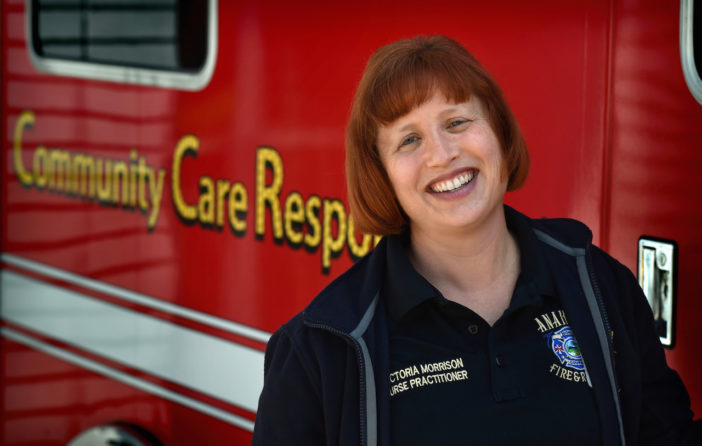On a hot July day in the back of an ambulance, Victoria Morrison senses it’s time to lighten the mood a bit. Half to distract and half to reassure her patient.
The timing is impeccable. As her right hand holds forceps and suture, her left hand puts a stitch through the skin of a woman’s forehead.
“I’m not the fastest with stitches,” she tells the woman, “but I do ’em right.”
The woman chuckles in response. Morrison’s gentle self deprecation, like the stitches, are much appreciated.
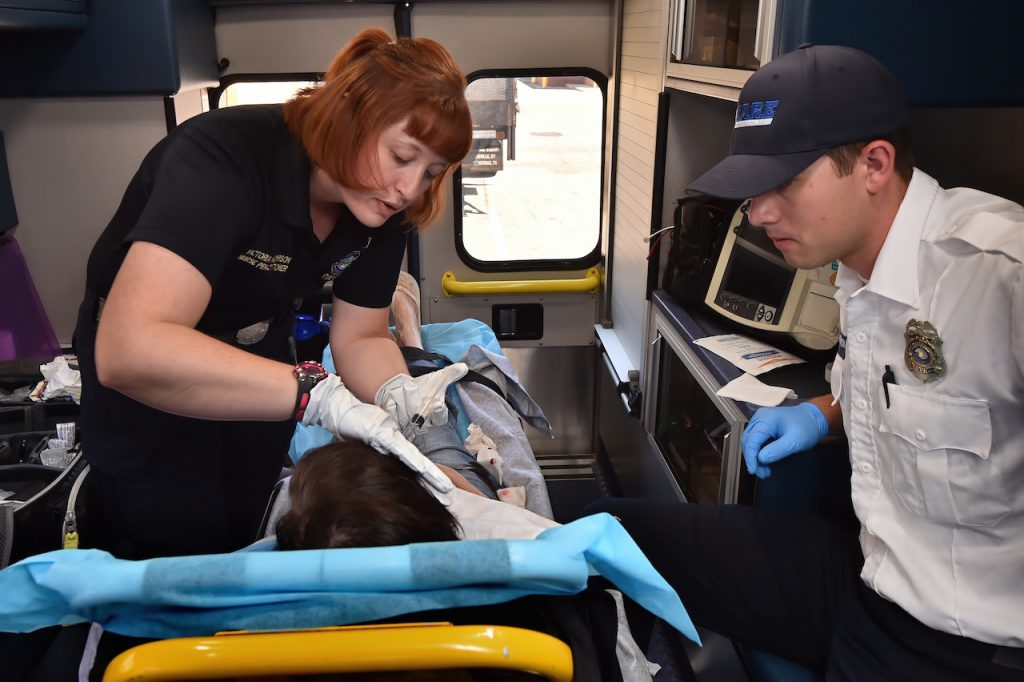
Nurse Practitioner Victoria Morrison works with EMT Lucas Dochmaschewsky, as part of Anaheim Fire & Rescue’s new Community Care Response Unit (CCRU), as she administers a local anesthetic before stitching up a woman’s face. The woman suffered a fall.
Photo by Steven Georges/Behind the Badge OC
At the moment, Morrison is providing something the woman would likely have to wait hours for at an ER: Immediate, quality medical care and a little old-fashioned bedside manner.
Morrison is a nurse practitioner who leads Anaheim Fire & Rescue’s Community Care Response Unit. The first of its kind in Orange County, it’s modeled on a program begun in Mesa, Arizona and started as a public-private partnership mostly paid for by a grant from Kaiser Permanente to support innovative projects.
In her specially equipped ambulance leased from Care Ambulance Service, and now budgeted for by the City of Anaheim, her mission is to take some of the load off paramedics and, as she says, “keep patients out of the hospital.”
Morrison’s job is essentially to be a mobile urgent care, but without the diagnostics.
She doesn’t go to car accidents or fires. But she can stitch up or staple wounds, treat dog bites, allergic reactions, dislocations, colds, flus and vertigo. She can administer antibiotics, I.V. fluids, nitroglycerin, steroids or a dose of pain medications when needed. Whereas paramedics often act as a triage unit prepping patients for the ER, Morrison can treat those who don’t need to go to the hospital, but need treatment.
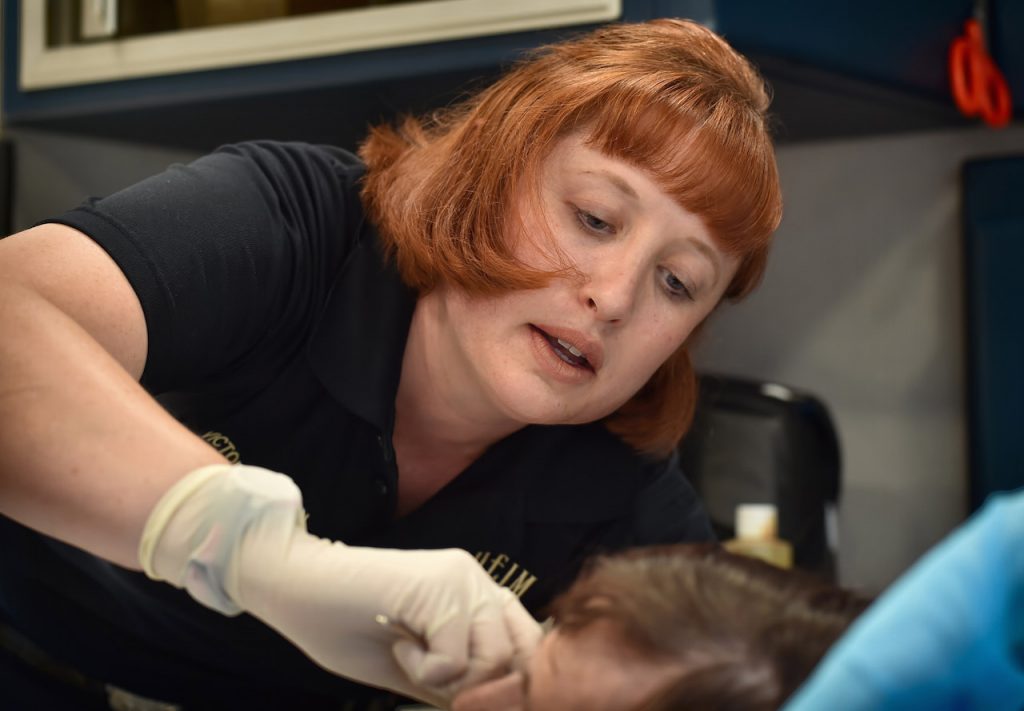
From inside Anaheim Fire & Rescue’s Community Care Response Unit (CCRU), Nurse Practitioner Victoria Morrison applies stitches to to a women’s face .
Photo by Steven Georges/Behind the Badge OC
The majority of people Morrison treats are elderly. About 20 percent of patients are homeless, a smaller percentage are teens and college aged. She rarely gets a call about a child. Occasionally, the captain will call her out to help make a better decision about a patient.
“You have to be very comfortable in your own assessments,” she says. And she should be. The Garden Grove native worked at Long Beach Memorial Hospital, UC Irvine Regional Burn Center, as well as in family practice, internal medicine and urgent care among other things before she just “fell into this” (she’s being self-deprecating again). Morrison, chosen out of a group of dozens of applicants, is also close to receiving her doctorate degree. She loves the “great collaborative mix” in the fire station.
“Every workplace has its own culture, its own barriers and its own whims,” she says. In this environment, “you have to be very good at dealing with right-here-right-now.”
She and the program have dealt quite well indeed. In its two-year existence, the CCRU has been dispatched over 1,700 times, and has prevented 57 percent of the 554 patients she’s treated from making an unnecessary trip to the ER.
It also has expanded the availability of the Advanced Life Support units for the City by freeing the engine and truck companies 83 percent of the time that the unit is on a call, to cover greater emergencies.
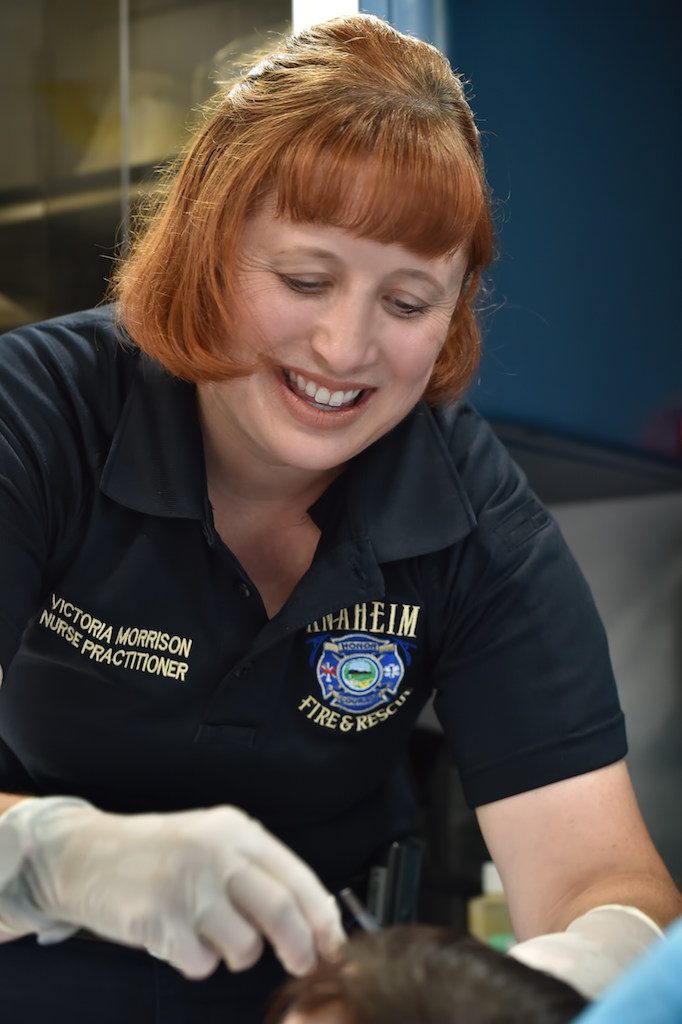
Nurse Practitioner Victoria Morrison gives a smile to her patient to help ease the woman’s stress as she applies stitches to her face while inside Anaheim Fire & Rescue’s Community Care Response Unit (CCRU).
Photo by Steven Georges/Behind the Badge OC
“With the increased rate that the CCRU treats and releases patients in the field,” says EMS Coordinator, Capt. Dave Barry, “[in Medicare terms]we have saved over $91,000 in transport costs and $188,000 in potential emergency room costs. If other billing costs are used, the cost savings jumps to over $580,000.”
About 20 minutes ago, the woman, in her 60s, tripped and fell, hitting her head while shopping a few blocks from her home. Paramedics were called out. Morrison arrived a minute or two later. She assessed the woman, who was a bit shaken up but OK. Stitches for the four-inch cut next to her right eye and a tetanus shot were in order.
As the patient began to relax, Morrison’s tone shifted from soothing to more conversational. The woman said her daughter and granddaughter will be arriving later in the day and she has a scheduled appointment to see her doctor a few days later.
It’s a good pivot point for Morrison, who often follows up with patients. In some cases, she will help set up doctor’s appointments or visits with a specialist. Often, she’ll just check in and see how they are doing a few days later.
It ensures a greater level of success and a deeper level of service, but also helps provide the sense of “community” that is fundamental for Anaheim Fire & Rescue. For that, there are no stats, but the value is priceless.
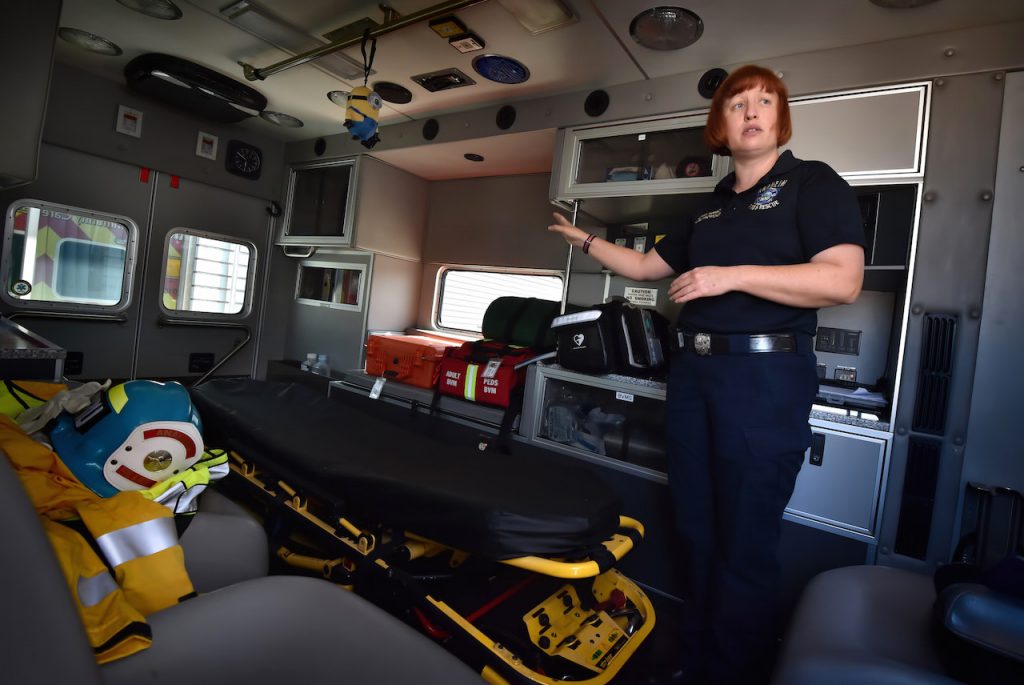
Nurse Practitioner Victoria Morrison shows Anaheim Fire & Rescue’s Community Care Response Unit (CCRU).
Photo by Steven Georges/Behind the Badge OC
Victoria Morrison, a nurse practitioner working with Anaheim Fire & Rescue’s new Community Care Response Unit (CCRU).
Photo by Steven Georges/Behind the Badge OC
 Behind the Badge
Behind the Badge
